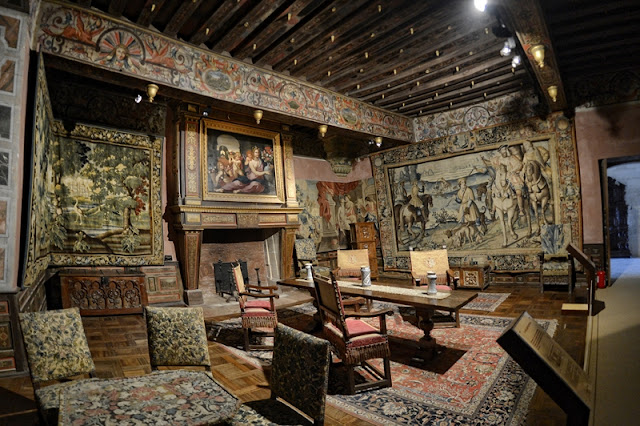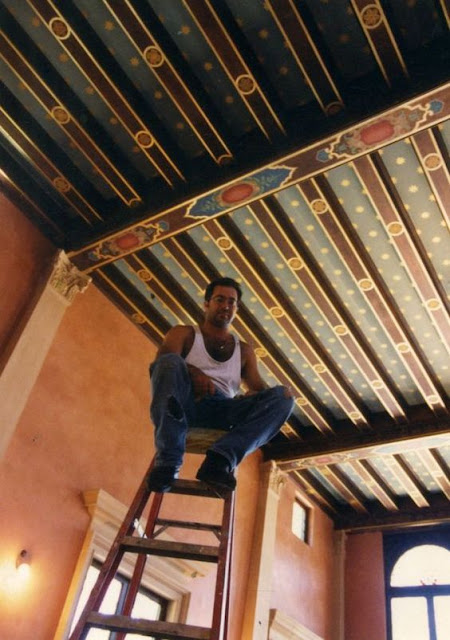Decorators are always telling their clients to "consider your 5th wall". Homeowners, or better said, Château owners during the Renaissance in France certainly paid attention! I was interested in learning more about the beautifully hand painted Renaissance ceiling beams prominent in many of these chateaux, and am sharing what I discovered with you via the blog.
In the later Middle Ages it became fashionable to lower the ceilings of the great halls in castles by installing wooden ceilings constructed with wooden beams. Over the period of the Renaissance, simple and functional gave way to highly decorated. Beams were used to emphasize the horizontal expanse of the ceiling and usually these beams were painted in magnificent colors.
Most people will never actually decorate with painted Renaissance style beamed ceilings. However, some of you DIY'ers might just be inspired to purchase some of the great faux beams on sale today, drag out your stencils and go to work. Either way I really do hope you will enjoy the images and history.
Even though in Medieval times the overhead beams had a functional purpose of supporting the weight of the roof, the French, with their desire for aesthetic appeal, turned the ceilings into works of art. Of course their ceiling beams are going to be decoratively painted as these are at Château des Doyens. Who would expect less!
The Château de Pierrefonds is one of France's most handsome and imposing medieval castles.
The Renaissance began in Italy in the 15th century but it didn't gain prominence in France until around one hundred years later. Italian ceilings were know to be rich with relief, frescoes, and paintings so wealthy French noblemen employed these experienced painters to paint the ceilings of their châteaux and castles. Much of the decorative ceiling beam work in the châteaux of the Loire valley was executed by Italian craftsmen.
The beams of these French Renaissance ceilings are the larger pieces and the joists are the many smaller lengths that are placed between the beams. The joists are usually supported by a lambourde, a piece of wood attached to both sides of the beam. Both beams and joists were painted.
Now, thanks to the French, these utilitarian beams would include a decorative purpose that brought an aesthetic appeal with their addition to a space. This decorative system was called ceilings à la française.
During the Renaissance not only the ceiling had painted beams and joists but the whole room would be covered in painted decoration in a cohesive way. At the Château de Fontainebleau the Galerie des Cerfs is decorated in this style.
The Guard Room of the Château de Fontainebleau was also covered in this way. The painter would decorate the sides of the beams and joists, then would finish the bottoms of both in another design of some kind to make it more interesting and less repetitive. Then the rest of the room would then be exquisitely painted.
This was a very distinct style of interior design that created a trend. In the French Renaissance the entire room, from beams to floor, would be heavily decorated .........much like the King's Bedroom in the Royal Château de blois.
The painted beams in Catherine de’ Medici's bedroom in the Château de blois.
The painted beams in the ceilings top off the Portrait Gallery and coordinate with the decoration on the walls.
This salon in Château de Poisses was decorated in French Renaissance style by the Comtesse de Guitaut, née Balivière, who for years, lying on a scaffolding, stenciled the patterns of the ceiling after having composed them herself after being inspired by examples found in the castles of the Loire and the surrounding area.
The famous Marquise de Sévigné lived in this room during her stays in the château. The ceiling dates from the beginning of the 17th century and represents the flora of Burgundy.
philippe.hemmel's photos on Flickr
Exposed painted beams like these in Château de Mauriac are eye catching features that draw the eyes up and bring drama to the ceilings.
Another image of the large expanse of intricately painted ceiling beams in the salon of the Château de Mauriac, built in the 13th-14th century and located in Senouillac, France.
Beautiful painted beams in Nikki Parker’s Paris apartment in the Place des Vosges, decorated by Jacques Grange.
The Renaissance painted beams of Château de Gizeux, in the heart of Touraine, which is now a chambre d'hôte, the equivalent of the English Bed and Breakfast.
The Marquise’s bedchamber in the Château de Cormatin, a majestic 17th-century château in southern Burgundy
The ceiling ‘à la française’ is spectacular, with it's painted beams in blue lapis lazuli, white and gold relief, and flowers baskets.
cluny-tourisme.com/Château de Cormatin
A close-up of the painted beams and joists in the château bedchamber. The beams are the larger pieces and the joists are the many smaller lengths that are placed between the beams. The joists are usually supported by a lambourde, a piece of wood attached to both sides of the beam.
The finely painted exposed ceiling beams of Château de Cheverny create a lively colorful mood. This is called Ceiling in Vivid Tone.
Photography by Mark Alexander via lostpeony.com
It was not until the seventeenth century that French painters were to make a major contribution to the history of art. Jean Monier, was responsible for the ceilings and other wall decorations in Château de Cheverny.
Another view of this incredible interior.
The guard room of Château de Cheverny with it's intricately painted beam ceiling, collection of arms, and armor.
@Chateaucheverny via Twitter
Château d'ancy is a Renaissance style château of the 16th century, located in the town of Ancy-le-Franc in the department of Yonne, France. The château has several painted beam ceilings.
The painting of the interior walls and ceiling beams of Château d'ancy is attributed to the most celebrated Italian, Flemish, and Burgundy artists of the 16th and 17th century.
The Château de Brissac has several rooms with Renaissance painted ceiling beams. Originally built as a castle in the 11th century, it was rebuilt in the 15th century by the Chief Minister to King Charles VII of France.
A view of one of the Château de Brissac's enchanting bedrooms with painted beamed ceiling.
And yet another! These painted beams also helped to make really high ceilings seem a bit warmer and cozier.
Renaissance painted beam ceilings in the Salon Francois room of Château de Chenonceau, built in 1514–1522 in the Loire valley, France.
The Château de Beauregard is a Renaissance château in the Loire Valley in France, located on the territory of the commune of Cellettes. The château is renowned for it's Gallery of Portraits with painted beams decorated in the 17th century and 327 portraits of famous people.
The dominant color of the painted beam ceiling, the blue, was obtained with powdered lapis lazuli, estimated price at the time..... seven times that of gold.
Heart be still! I love this library complete with painted beams! They bring depth, texture, and color to the ceiling.
In 13th-century Château de Ménessaire, located in the Côte d'Or département in eastern France, the ceiling beams are painted in the Vivid Tone style of bright colors such as blues, reds, and greens. These colorful beams give the ceiling a brightness especially enhanced by the gold colored walls.
This painted beam ceiling at Château Vaux-le-Vicomte is interesting in that it is decorated in a style that represents highlights and shadows by using a single color, usually brown, over a neutral.
You have seen several ceilings painted in Vivid Tone so now let's turn our attention to ceilings in Quiet Tone style. These painted beams are usually more subtle as can be seen here at Château de Fléville.
Painted beam ceilings of 12th century Château de Rouffillac, now in existence for over 900 years.
I love the simple yet elegant Quiet Tone painted beams of Château de Montpoupon. A fortified castle dating back to the Middle Ages, built under Charlemagne, Montpoupon was transformed in the 16th century to become a Renaissance château.
I am a fan of the painted beam ceiling because, when executed in less grand style, they can exude a warm, rural, French Renaissance château style as seen in this bedroom at Château de Montpoupon.
The dining room beamed ceiling at Château de Montpoupon is painted in grisaille. Grisaille comes from the French word for grey and is a painting technique in which an artist uses similar neutral grey colors.
Floral patterns are not uncommon on painted ceiling beams. Here at Château de Josselin, flower stems are used repetitively along the bottom of the beams
Artist, Roberto Bricchi via Houzz
Again a stylized floral motif is used on these painted beams.
The stencil style painted ceiling beams in Fiches Castle, Verniolle, France exude the charm of French country style.
Painted beams can also be seen in other castle in Europe. These in 12th century Eltz Castle in Germany are painted in an almost "fairytale" style.
Another interior view of Eltz Castle's unique painted beams.
The folk art style painted beam ceiling of Delgatie Castle, Aberdeenshire, Scotland.
And, of course, there are the fabulous painted beam ceilings of Hearst Castle, the palatial estate in San Simeon, California and home of publishing tycoon, William Randolph Hearst.
Photo by robertwillem2 on
Over thirty ceilings, doorcases, mantels, and decorative panels were purchased in Europe and transported to California where they were installed at the castle.
Incredible painted beam ceiling in Hearst Castle
via Pinterest
And I couldn't resist sharing this one as well.
The painted beams in the hall at the Château de Sully. Built in 1570-1610 it is the largest of the Renaissance chateaux of southern Burgundy. Many château owners do not even know that they are the proud owners of a ceiling à la française as the painted beams have been stuccoed over. The 1660's can be considered as the period during which the ceilings à la française trend of the day was over.
A magnificant painted beam ceiling in Château de Montvallat, located in Cantal in the town of Chaudes-Aigues. Unfortunately French Law does not protect any old medieval house nor these precious pieces of art.
Owners have been known to simply pry the painted boards from the ceilings and sell them on Ebay.
Ceiling by Joe Nicoletti
Just the opposite of the homeowners mentioned above are artists like this that will create fabulous ceilings à la française for your modern day castles.
A plain or ordinary room can be transformed with the addition of Renaissance style painted beams.
Cozy, comforting, charming.......just some of the words that describe the feelings Renaissance style painted wooden beams bring to any home.
Now if some of you say "I would love to have this look" and you are artistic, you really should give it a try. Even if you stencil them instead of free hand the art. Remember Comtesse de Guitaut, née Balivière from image #10......you really don't have an excuse!!
Click below to see the previous post.
This blog post was published by Lisa Farmer
In the event that I have not credited the correct source of an image, please contact me at lisafarmerdesigns46@yahoo.com and I will be glad to correct it.































































